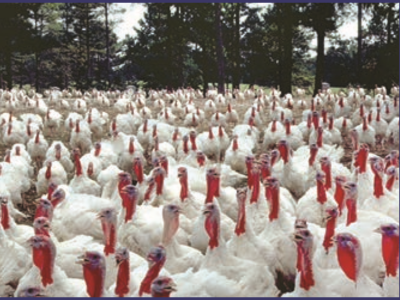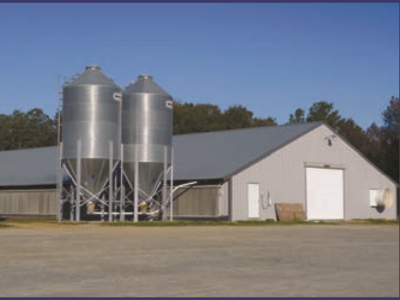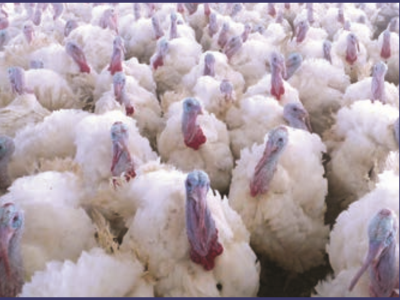



US Poultry Industry Manual - turkey finishing
Pasture and confinement finishing, mortality, record-keepingEditor's Note: The following content is an excerpt from Poultry Industry Manual: The Foreign Animal Disease Preparedness and Response Plan (FAD PReP)/National Animal Health Emergency Management System (NAHEMS) Guidelines which is designed to provide a framework for dealing with an animal health emergency in the United States. Additional content from the manual will be provided as an article series.
Key to managing turkeys during finishing is to provide adequate ventilation, clean cool water, good quality feed, and a healthy sanitary environment with sufficient space. The importance of animal husbandry and management cannot be over emphasized. Disease is usually an indication of a failure in management – something was done that should not have been done, or, conversely, something that should have been done was not done.
Range (Pasture) Finishing

Initially, turkeys were produced during the summer on open range, primarily for the Thanksgiving and Christmas holidays. Small turkey flocks for niche markets are still raised this way, but finishing on range is rarely used anymore for commercial flocks. Poults are obtained in late winter or early spring and brooded in a brooder house. After brooding, at about 8 weeks of age, they are moved onto pasture where they remain until they are processed. Number of turkeys per acre varies widely from 100-250 depending on soil type and vegetation. Part of the nutrition for the birds is provided by the environment, but the turkeys still require commercial feeds. Shelters, feeders, and drinkers are provided. Roosts and 2-3 ft2 (0.2-0.3 m2) of floor space are provided under the shelters. Health problems include predation, weather-related losses, theft, and diseases contracted from free-living animals. Fowl cholera, caused by Pasteurella multocida, is often present in the mouths of rodents and small carnivores, including dogs and cats. It is a common cause of high mortality in range flocks. Free-living birds, especially migratory waterfowl, can shed avian paramyxoviruses and influenza viruses in their feces and introduce them into the flock. Dividing the pasture and periodically rotating the flock through the different sections reduces disease risks.
Confinement Finishing
Finishing houses are prepared for the arrival of the turkeys from the brooding house, but, unless there was a disease outbreak in the previous flock, they are only completely cleaned and disinfected annually. Equipment is checked, repaired, and structural repairs are done as needed. Water lines are flushed and disinfected. Feed lines are emptied and cleaned; feed bins are inspected for residual caked feed and cleaned if indicated. Entryways and areas around the house are inspected and cleaned. Vegetation along the sides of the house is sprayed with herbicide and rodent bait stations are replenished. Caked litter is removed and the remaining litter worked so that it is friable. Litter is occasionally composted by moving it into one or more raised “wind-rows” the length of the house. Heat from composting significantly reduces infectious agents in the litter. If the floor is exposed, rock salt, at the rate of 75-100 lbs (34-45.5 kg) per 1000 ft2 (93 m2) can be applied to dehydrate and kill coccidia oocysts and helminth eggs. Litter is spread evenly throughout the house to a minimum depth of 4 in (10 cm). Litter from empty brooding houses may be added to ‘top dress’ litter in finishing houses. After the turkeys are in the house, caked litter that builds up along feed lines and around drinkers needs to be removed and replaced.
Hens and toms are provided with at least 2 ft2 (0.2 m2) and 3 ft2 (0.3 m2) of floor space respectively. Stocking densities of 6-10 lbs/ ft2 (29-49 kg/m2) are recommended and should not exceed 15 lbs/ ft2 (73 kg/m2) when environment and management are ideal. Stocking density in summer may need to be lower than it is in cooler months. Higher stocking densities are possible with controlled ventilation housing compared to naturally ventilated housing. Overcrowding results in increased mortality, lower weights, decreased feed utilization, and downgrading at processing.
For a few days after the turkeys arrive from the brooder house, it helps for the grower to keep feeders full to encourage them to eat, and to frequently walk the birds so they can quickly adjust to their new surroundings. The turkeys will not need this much attention when they become accustomed to their new environment, and the amount of feed in feeders can be reduced to minimize spillage.
Light influences activity, eating, drinking, and growth. Excess light contributes to aggressive behaviors and persecution. Lighting programs vary; 8-10 hours of darkness are recommended with a minimum of 4 hours of darkness. Intermittent lighting programs in which lights come on and off every few hours during the night are sometimes used in an effort to stimulate eating and increase growth.
During finishing, turkeys should be checked at least twice daily; more frequently if there is a problem. Time spent with the flock provides added benefits because turkeys socialized by frequent contact with people are healthier and more productive than turkeys that are not well socialized. Movement through the birds needs to be slow and unhurried. Fast movement or poor socialization causes the turkeys to become frantic, and injuries can result from their efforts to escape a person’s presence by attempting to fly. If the flock is close to processing, injuries result in increased downgrading of the turkeys because of scratches, bruises, and even possible wing fractures. Healthy, socialized turkeys are alert and inquisitive. They follow behind the person checking the flock and peck at their boots and clothing. Adult tom turkeys may not be checked as frequently prior to processing because of aggressive behavior towards people.
As turkeys drink right after they eat, feeders and drinkers should be located close to each other (8-12 ft; 2.4-3.7 m). Bell drinkers (“plassons”) are spaced about 30 ft (9.1 m) apart; each one is sufficient for 100 birds. Feeders and drinkers need to be adjusted to the average shoulder height every 2-3 days because of the turkeys’ rapid growth. In hot weather, allowing water lines to drip slightly at the end outside of the house will help keep cool water in the lines. Water temperatures above 86°F (30°C) reduce consumption by the birds. Obviously dirty drinkers are cleaned, but it is not practical to attempt daily cleaning. Any waterers that are leaking are repaired or replaced. Similarly, grossly contaminated or caked feed is removed and discarded. Water levels are adjusted to 0.5-0.75 in (1.3-1.9 cm) and feed levels set at a depth of 2-3 in (5-7.6 cm).
Drinkers can be rotated to prevent heavy caking of litter by moving them in a 3- (triangle) or 4-point (square) pattern using extra hooks from which the drinkers can be suspended. If litter around a drinker is excessively wet, the height of the drinker and depth of water in the drinker lip is checked and adjusted. Soaked litter needs to be removed and replaced as quickly as possible. Drinkers that are leaking must be shut off and repaired as soon as they are found. Controlling moisture in the house with ventilation under ideal conditions is difficult enough, let alone when unnecessary extra water from faulty drinkers has been added to the environment.
Proper ventilation minimizes ammonia and dust, and helps control litter moisture. Ideal litter moisture is between 25-40%, but it varies widely depending on the location in the house. Litter moisture below 25% predisposes to dusty conditions and aspergillosis, while ammonia and fly multiplication occur when levels are above 40%. Excessively moist conditions provide ideal conditions that favor the survival of enteric pathogens including bacteria, viruses, and coccidia. Adjustments to the ventilation can be done during daily flock checks. These should be done as early as possible so that the result(s) of the change(s) can be confirmed as correct. It may be necessary to return to the house later to check on the changes. As a general rule of thumb, if conditions in the house feel good to the grower, they are probably about right for the turkeys as well. Fans are adjusted to achieve recommended temperatures and air exchanges.Turkeys are more susceptible to high heat and humidity than chickens and must be kept as cool as possible during periods of excess heat. Keeping the galvanized roof of the finishing house in good condition by covering rusted areas with reflective paint will help reduce heat buildup in the house. Circulating or box fans, with or without supplemental misting, may be needed to get sufficient air movement over the turkeys. Evaporative cooling using misting systems, cool pads, and sprinkler systems on the roof can be useful during periods of extremely hot conditions, especially when relative humidity is low. If birds are being finished in tunnel houses, they have evaporative cooling, but still need to be managed to minimize heat stress. Automated in-line generators and alarm systems are essential for solid-wall tunnel houses to provide electricity and alert the grower when there is a power failure. During a power failure, heat buildup reaches lethal levels in as short as 20 minutes and can lead to loss of the entire flock if power to run the fans is not restored quickly. Back-up generators and alarms should be tested at least once every month to make sure they respond when the power is turned off and fuel levels in the generators should be checked.

A thorough search for dead birds and their removal must be done every time the flock is checked, as these are potential sources of disease for the rest of the flock. Disposal of dead birds occurs by burning, composting, or rendering unless they are needed for diagnostic purposes. Burial does not work well on most farms because scavengers dig up carcasses and effluent from decomposing carcasses may contaminate the aquifer. Mortality is recorded on a standard form and reported to the company. Excess mortality events (>1/1000), without an obvious cause, should be reported. If mortality is extremely high (>1/100), this constitutes an emergency, and should be reported to the integrator immediately along with preventing traffic from coming on or off the farm until the cause is identified and possibility of a foreign animal disease has been ruled out. Disposal of hundreds of dead turkeys near market age can present problems as they usually have to be taken to a landfill that will accept them. If mass depopulation is needed, in-house composting may be an alternative, but heat from composting can be a fire hazard if carcasses are too large. Communal disposal or dead bird pickup sites are frequently responsible for spreading disease in an area and are not recommended.
In addition to dead birds, cull birds should be identified and euthanized if they are non-responsive to stimuli, do not move away when approached, cannot get to food or water, are a disease risk for the flock, are severely persecuted by other birds, are not marketable, or for humane reasons. Birds do not show pain as we do, so one’s judgment has to be used to determine euthanasia for humane reasons. Several methods of euthanasia are available, but no method is completely satisfactory. After suitable training, cervical dislocation and blunt force trauma are commonly used to euthanize smaller and larger turkeys respectively. Other methods of euthanasia are not readily available to producers (American Veterinary Medical Association, 2007). Recently the Turkey Euthanasia Device, a non-penetrating captive bolt stunning device, has become available to euthanize larger birds by blunt force trauma (http://www.turkeyeuthanasiadevice.com/).
Light hen, heavy hen, and tom flocks finish their production cycles at around 14, 18, and 20 weeks of age respectively. Typical average weights are 14-15 lbs (6.4-6.8 kg) for light hens, 18-20 lbs (8.2-9.1 kg) for heavy hens, and 40-45 lbs (20.4 kg) for toms, but vary widely based on company and region. These weights and ages match those when the turkeys are most efficient with respect to rate of growth and feed utilization. Transferring turkeys from finishing houses to coops on live-haul trucks so they can be taken to a processing plant is termed “load-out”. Load-out is done at night to decrease stress on the birds, to move the birds when temperatures are cooler, and to have the turkeys at the processing plant the following day. Turkeys are often put on continuous light for up to a week to prepare them for load-out. Feed lines are turned off several hours before load-out so the turkeys can consume feed remaining in the pans. Approximately 12-14 hours before the turkeys are scheduled to be processed, feed lines are raised. This empties the digestive tract of the turkeys prior to processing to minimize contamination from fecal material and ruptured crops. Water is generally not restricted. A weight loss of around 10%, termed “shrink”, occurs between load-out and processing, mostly from emptying of the digestive tract.
Mortality

Mortality includes birds that die and those that are culled (see above). It results from a variety of causes including failure to adapt after hatching, infections and infectious diseases, genetic disorders, developmental defects, accidents, and other non-infectious disorders. In well-managed flocks, the majority of deaths result from non-infectious causes. Losses are greatest during the first week of life, but should not exceed 2%, unless poults are from either young or very old breeders, in which case it may be as high as 4-5%. Poults from young breeders are smaller, not as developed, and have greater difficulty starting. After the first week, mortality should be less than 0.5% weekly. Investigation of daily mortality exceeding 0.1% or weekly mortality exceeding 1% should be done. In tom flocks, mortality gradually increases after 16 weeks and may reach 1% per week by the time they are processed because of increased aggression as they approach sexual maturity and musculoskeletal disorders. Total mortality depends on the type of turkey and duration of the production cycle. Hens usually finish with total mortality of 5-6% while total tom mortality is 10-12%.
Losses from mortality accrue from the value of the turkey when it dies, which includes the feed it has consumed, and potential product market value. The most expensive mortality occurs when birds die en route to the processing plant; least expensive mortality results from losses just after placement. When evaluating mortality, value of the turkey at the time it dies needs to be considered rather than just total mortality.
Flock Records
Several records are kept on each flock including poult placement ticket, feed delivery tickets, service technician’s flock evaluations, mortality chart, processing results, and flock close-out record. Some companies also use a biosecurity log to record who goes onto a farm, where they came from, when they arrive and leave, and purpose of their visit. Poult placement tickets provide information on the number delivered, conditions, breed, and breeder flock source, permitting traceback to specific breeder flocks. Feed delivery tickets document the time, amount, and type of feed delivered to the flock. Flocks are periodically visited and evaluated by service technicians, employed by the company, to provide growers with advice and technical information. They also handle routine management and health issues. An evaluation form is completed and provided to the grower at each visit. Mortality is recorded daily by the grower on a standard form and periodically reported to the company. A final summation of the flock’s overall performance that incorporates the various records that have been kept on the flock is generated via a computer to provide all of the relevant production and economic information. This often is used to compare flock performance among similar flocks marketed during the same time period.
Reference: "USDA APHIS | FAD Prep Industry Manuals". Aphis.Usda.Gov. 2013. https://www.aphis.usda.gov/aph...
The manual was produced by the Center for Food Security and Public Health, Iowa State University of Science and Technology, College of Veterinary Medicine, in collaboration with the USDA Animal and Plant Health Inspection Service through a cooperative agreement.









